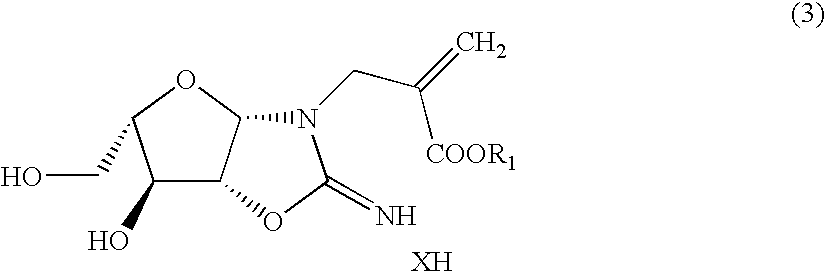L-nucleic acid derivatives and process for the synthesis thereof
a technology of lnucleic acid and derivatives, which is applied in the direction of sugar derivates, organic chemistry, chemistry apparatus and processes, etc., can solve the problems of safety and cost in industrial production, unsuitability of above process, and low yield
- Summary
- Abstract
- Description
- Claims
- Application Information
AI Technical Summary
Benefits of technology
Problems solved by technology
Method used
Image
Examples
example 1
Production of L-arabinoaminooxazoline-α-chloromethylacrylic acid adduct
[0119]Thionyl chloride (10.6 g, 89.1 mmol) was dropwise added to ethyl α-hydroxymethylacrylate (10 g, 76.8 mmol) with ice-cooling; stirring was conducted for 30 minutes; then, a reaction was allowed to take place at 90° C. for 2 hours. After the completion of the reaction, low-boiling compounds were removed under reduced pressure to obtain unpurified ethyl α-chloromethylacrylate (11.8 g). Then, L-arabinoaminooxazoline (11.8 g, 64.0 mmol) was suspended in dimethylacetamide (80 ml). Thereto was dropwise added the ethyl α-chloromethylacrylate (11.8 g) with ice-cooling. A reaction was allowed to take place at room temperature for 4 hours. The reaction mixture was concentrated under reduced pressure to remove the solvent. To the residue was added isopropanol (100 ml), and the resulting mixture was stirred at room temperature for 1 hour. The resulting crystals were collected by filtration, washed with isopropanol (10 ...
example 2
Production of L-2,2′-anhydro-5,6-dihydrouridine-5-exhomethylene
[0122]The L-arabinoaminooxazoline-α-chloromethylacrylic acid ester adduct (2 g, 6.20 mmol) obtained in Example 1 was dissolved in water (20 ml). Thereto were added hydroquinone (50 mg) and anhydrous sodium carbonate (0.9 g, 8.49 mmol) with ice-cooling. Stirring was conducted for 15 hours to give rise to a reaction. After the completion of the reaction, neutralization with diluted hydrochloric acid was made and the resulting mixture was concentrated to remove the solvent. The resulting residue was dissolved in methanol (20 ml). The resulting solution was dried over anhydrous magnesium sulfate, followed by concentration to remove the solvent. The resulting residue was purified by silica gel column chromatography (developing solution: chloroform / methanol) to obtain a title compound (0.187 g, 12.6%).
[0123]Analysis results of the title compound obtained
[0124]mp: 173–174° C. 1HNMR (DMSO-d6, 400 MHz) δ ppm: 3.22–3.36 (m,2H), 3....
example 3
Production of 2,2′-anhydro-1-(β-L-arabinofuranosyl)thymine
[0125]The L-arabinoaminooxazoline-α-chloromethylacrylic acid ester adduct (10.5 g, 32.6 mmol) obtained in Example 1 was dissolved in water (105 ml). Thereto were added hydroquinone (526 mg) and anhydrous sodium carbonate (5.18 g, 48.9 mmol) with ice-cooling. Stirring was conducted for 15 hours to give rise to a reaction. After the completion of the reaction, neutralization with acetic acid was made to obtain an aqueous solution (12.2 g, 86.9%) containing the L-2,2′-anhydro-5,6-dihydrouridine-5-exomethylene obtained in Example 2. Then, 5% palladium alumina (1.05 g) was suspended in water (52.6 g). Thereto was dropwise added the above aqueous solution at 80° C. in a hydrogen atmosphere and a reaction was allowed to take place for 1 hour. The catalyst was separated by filtration and the filtrate was concentrated to remove the solvent. The resulting residue was purified by silica gel column chromatography (developing solution: ch...
PUM
| Property | Measurement | Unit |
|---|---|---|
| Time | aaaaa | aaaaa |
Abstract
Description
Claims
Application Information
 Login to View More
Login to View More - R&D
- Intellectual Property
- Life Sciences
- Materials
- Tech Scout
- Unparalleled Data Quality
- Higher Quality Content
- 60% Fewer Hallucinations
Browse by: Latest US Patents, China's latest patents, Technical Efficacy Thesaurus, Application Domain, Technology Topic, Popular Technical Reports.
© 2025 PatSnap. All rights reserved.Legal|Privacy policy|Modern Slavery Act Transparency Statement|Sitemap|About US| Contact US: help@patsnap.com



